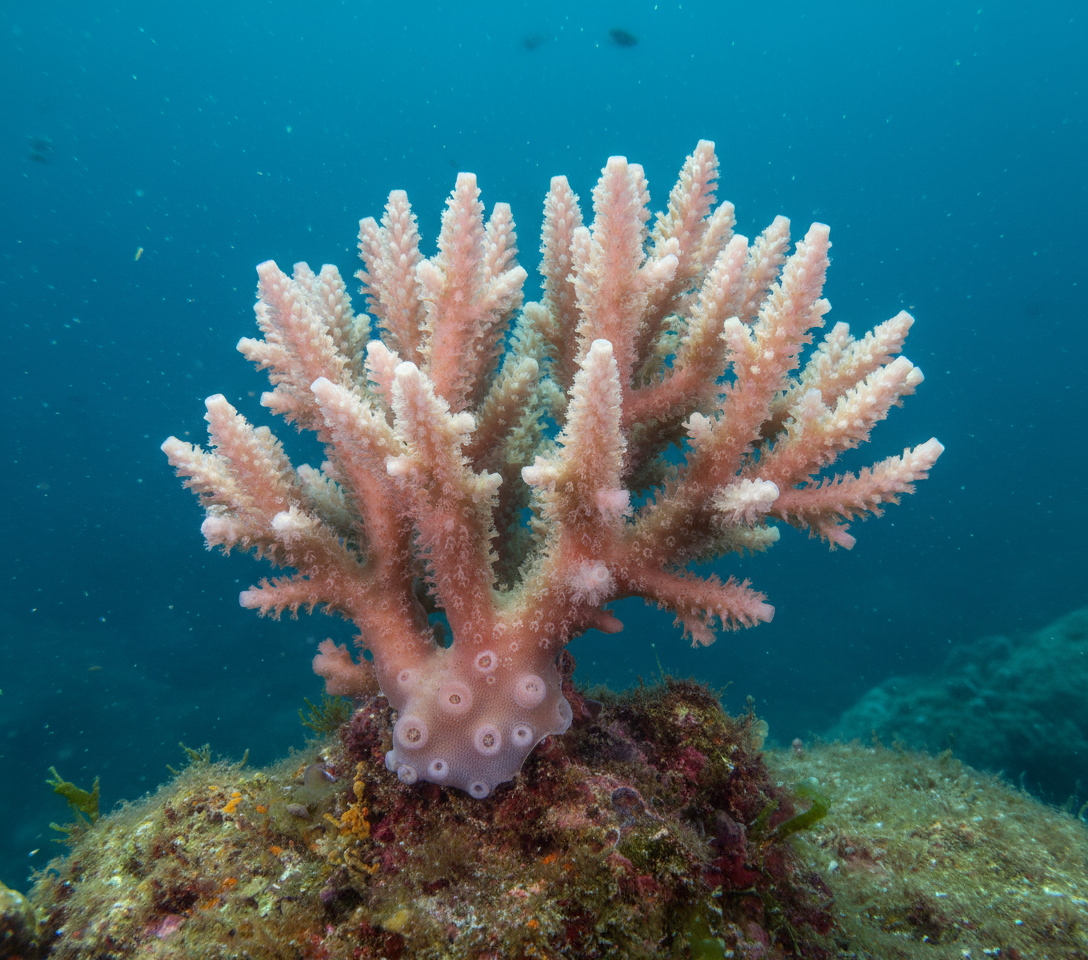Stylaster: Classification, Habitat, Characteristics, and Ecological Significance
Classification of Stylaster
- Kingdom: Animalia — Multicellular, heterotrophic organisms with complex cellular organization
- Phylum: Cnidaria — Aquatic animals with radial symmetry and specialized stinging cells (cnidocytes)
- Class: Hydrozoa — Predominantly colonial animals with polyp and medusa life stages
- Order: Anthoathecata — Hydrozoans characterized by athecate polyps lacking a protective covering
- Family: Stylasteridae — Calcified hydrozoan corals with rigid skeletons and polymorphic colonies
- Genus: Stylaster — Colonies forming rigid, calcified branching or encrusting structures in marine environments

Habit and Habitat
These species are marine hydrocoral organisms found primarily in cold and deep oceanic waters but also in some shallow tropical reefs. These corals form complex calcareous skeletons creating highly branched or encrusting colonies that contribute substantially to benthic marine habitats.
Often found attached to rocky substrates, wrecks, or deep-sea ridges, Stylaster thrives in areas with good water flow, facilitating nutrient and plankton capture for feeding. Their adaptation to deeper waters distinguishes them ecologically from typical reef-building corals.
Geographical Distribution
They exhibits a broad geographical distribution ranging from polar regions to temperate and tropical seas. They have been recorded in the North Atlantic Ocean, Pacific Ocean, Southern Ocean near Antarctica, and various island shelves.
Their presence in cold, nutrient-rich waters highlights their ecological versatility and importance in less-studied deep-sea habitats. Stylaster’s distribution also includes some of the world’s deepest coral ecosystems.
General Characteristics
- Colony consists of upright calcareous pink coloured tree like branches
- Surface bears of the gastropores body and dactylopores, arranged in a cyclic manner.
- Branches of the colony are provided with projections septa. with cup-like radiating Centre of each cup contains tentacle-bearing gastrozooid, surrounded by tentacleless dactylozooids.
- Gastrozooids are short and stout bearing few solid short projections.
- Dactylozooids are simple and hollow finger-line projection without tentacles arising from peripheral compartments.
- Cups rest on calcareous projection called as style and hence the name Stylaster.
- Style in a pointed calcareous projection present at the base of each cup.
- Cups are wihtout tabulate and rest on a calcareous projection called as style and hence the name stylaster.
- Medusae degenerate, forming sporosacs, lying inside the chambers of coral called ampullae. Young ones escape in planula stage.
- Colonies are composed of interconnected polyps with calcareous skeletons that are rigid and often ornate.
- Stylaster corals are polymorphic, exhibiting gastrozooids specialized for feeding and dactylozooids serving defense with nematocysts.
- Colonies exhibit branching, bushy, or encrusting growth forms depending on environmental conditions.
- The calcium carbonate exoskeleton provides structural support and habitat complexity.
- Polyps are typically small and embedded within skeletal cups (calices).
- Reproduction involves both asexual budding and sexual reproduction via medusoids or planula larvae.

Special Features
- They have unique among hydrozoans for its robust calcareous skeleton, contributing to deep-sea coral reef construction.
- Their ability to inhabit cold and deep waters expands coral reef ecology beyond tropical confines.
- Their complex colony structures offer crucial habitats for diverse marine invertebrates and fish.
- Stylaster skeletons have potential biomedical and paleontological value, serving as records of past ocean conditions.
- Their nematocysts provide potent stinging ability for defense, similar to other cnidarians.
Identification
Identifying Them involves noting colony morphology—highly branched or encrusting forms with rigid calcium carbonate skeletons. Small polyps inside well-defined calices distinguish them from other coral types. Field identification requires examination of colony surface texture, skeletal morphology, and habitat data.
Ecological Importance
They contributes to marine biodiversity by forming complex habitats serving as shelter and breeding grounds for numerous species, including commercially important fish and invertebrates. Their presence enhances ecosystem resilience and productivity in deep and cold water environments.
Due to their growth in the deep sea, Stylaster corals play a pivotal role in the stability of benthic ecosystems, influencing sediment dynamics and supporting biological communities.
Research and Conservation
It has garnered scientific interest for its ecological role in deep-sea environments, skeletal biomineralization processes, and evolutionary history. Their fossils contribute to paleoclimatology and understanding marine biodiversity through geological time.
Conservation efforts focus on mitigating impacts of deep-sea trawling, mining, and ocean acidification which threaten their fragile skeletal structures. Protection of deep-water coral habitats is crucial for preserving biodiversity and marine resources.
References
- Cairns, S.D. “Stylasteridae (Cnidaria: Hydrozoa) of the world: Monograph and revision.” Smithsonian Contributions to Zoology, 2016.
https://repository.si.edu/handle/10088/31141 - World Register of Marine Species (WoRMS) – Stylaster Linnaeus, 1758
http://www.marinespecies.org/aphia.php?p=taxdetails&id=117762 - Encyclopedia of Life – Stylasteridae Overview
https://eol.org/pages/712 - Wagner, D. et al. “Ecology and Distribution of Deep-Sea Stylaster Corals.” Marine Ecology Progress Series, 2020.
https://www.int-res.com/articles/meps_oa/m540p001.pdf - Geological and Biological Insights from Stylaster Fossils – Journal of Paleontology, 2019.
https://www.cambridge.org/core/journals/journal-of-paleontology/article/abs/insights-from-stylaster-fossil-record/xyz123 - These links provide reliable scientific information and taxonomic details on Stylaster coral.
